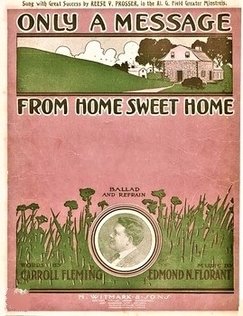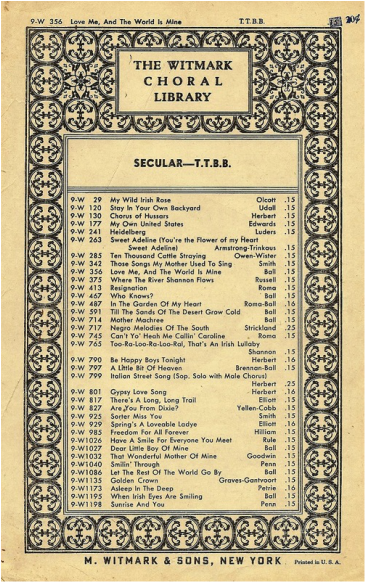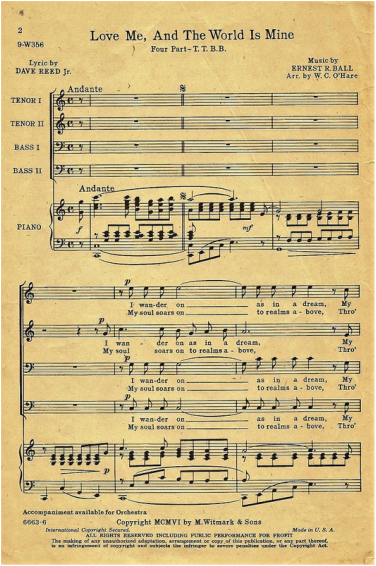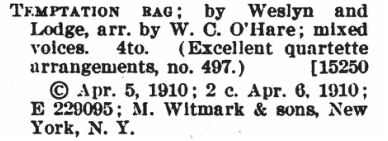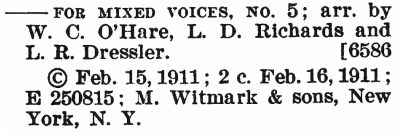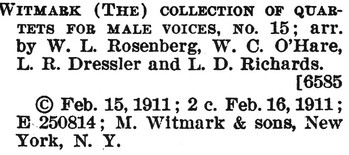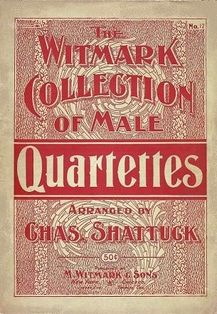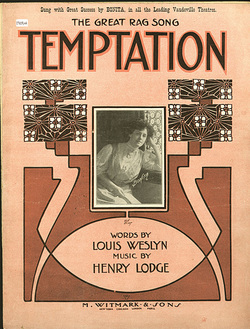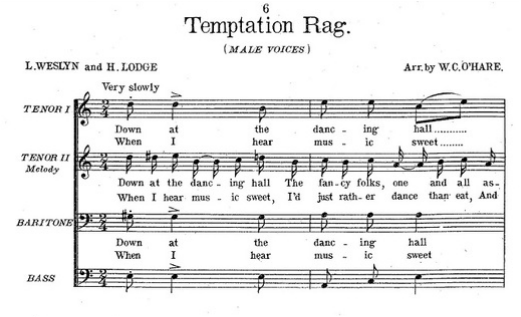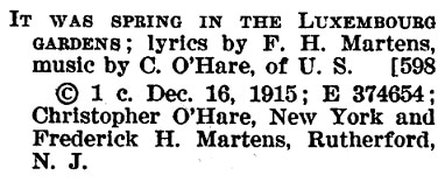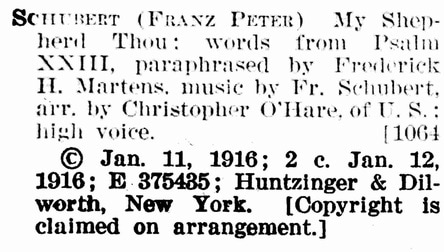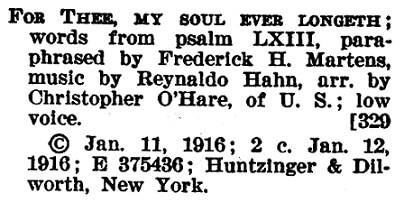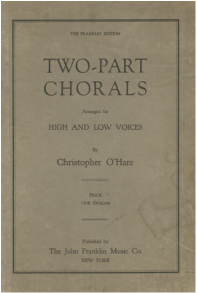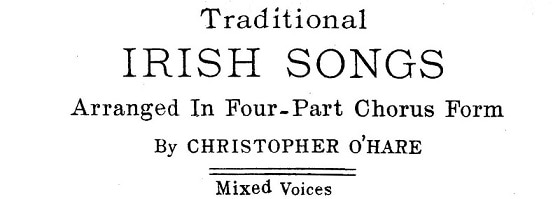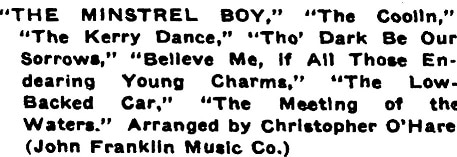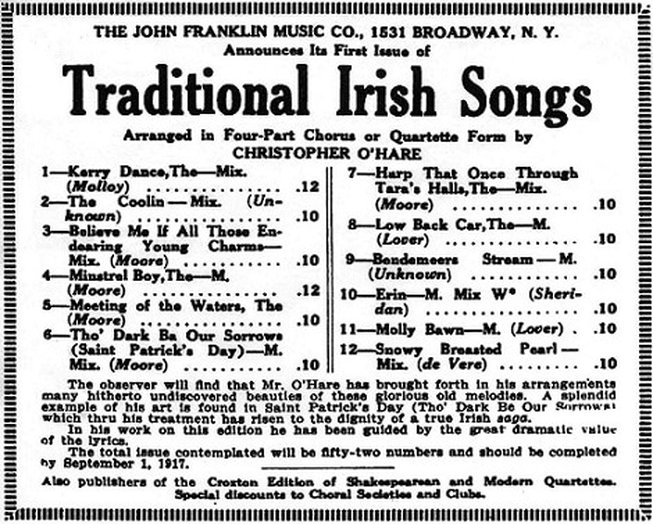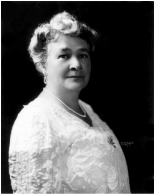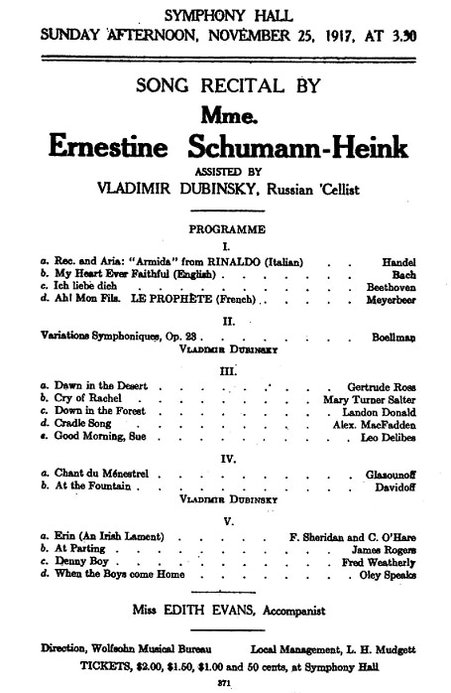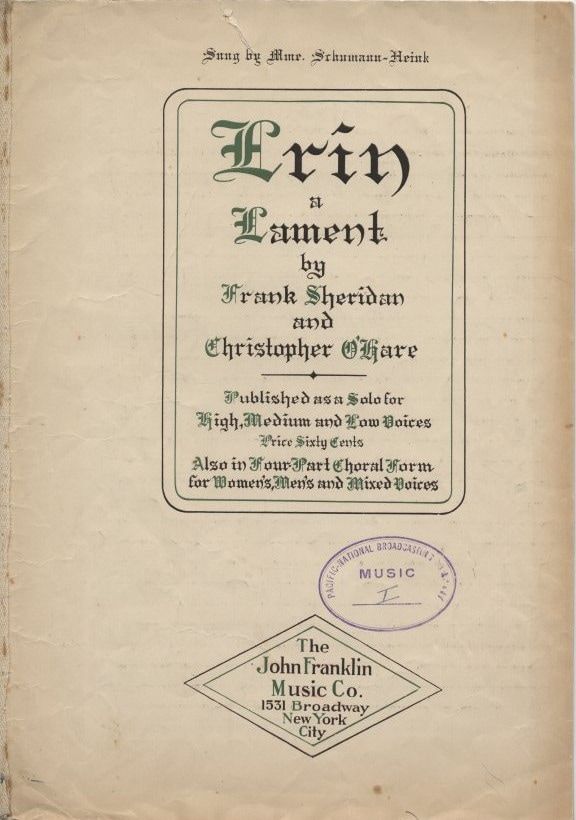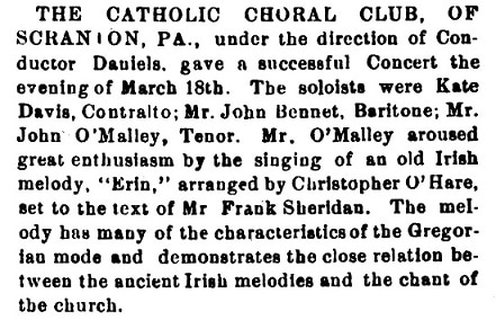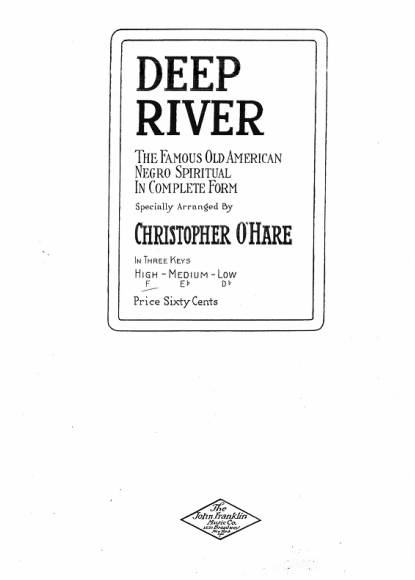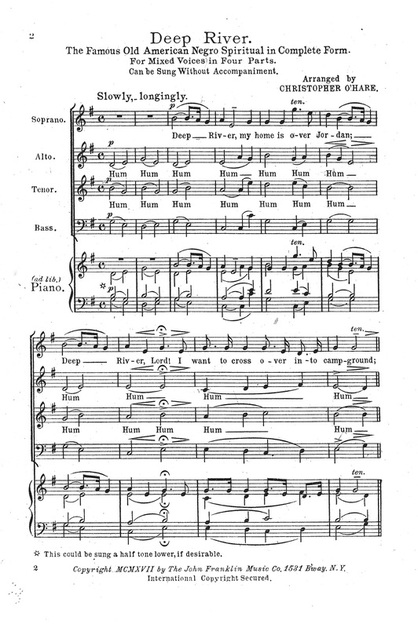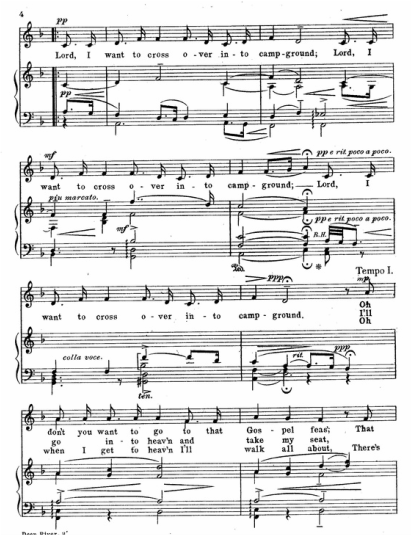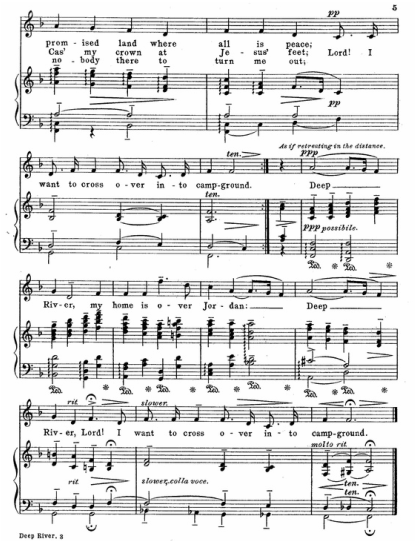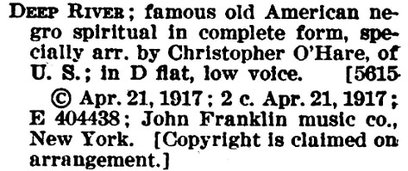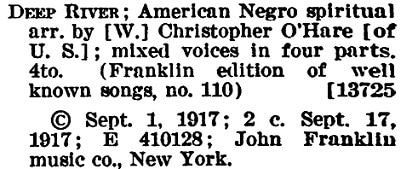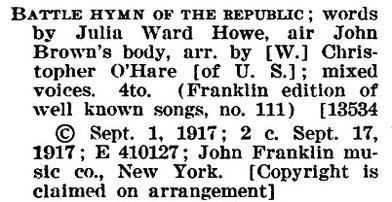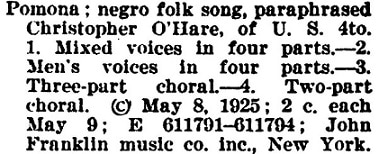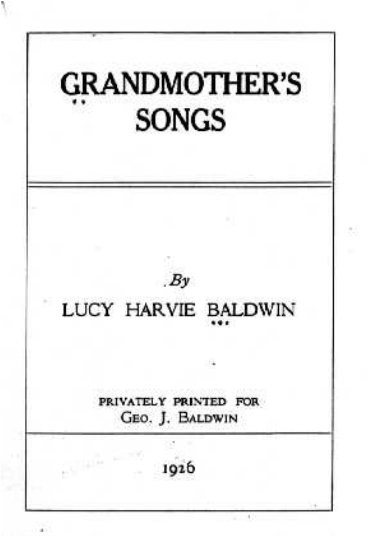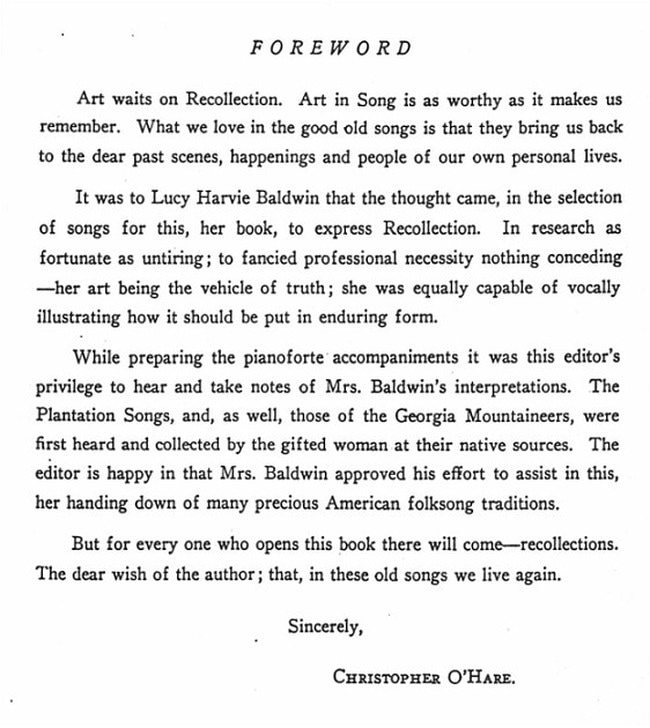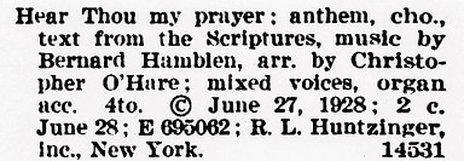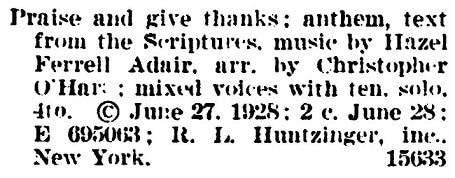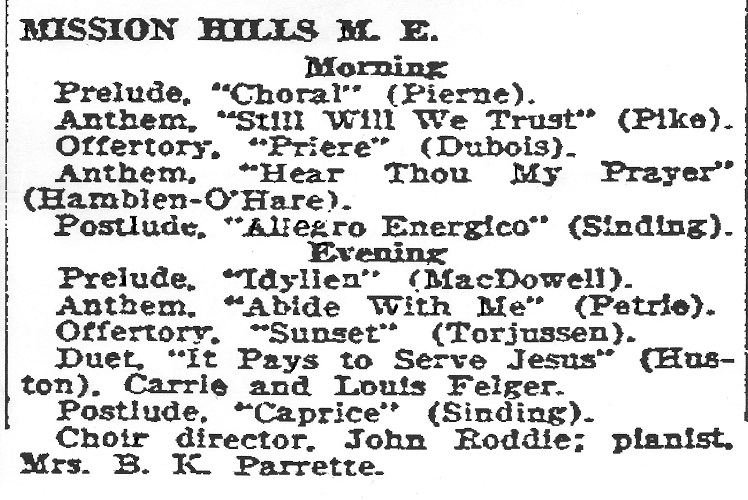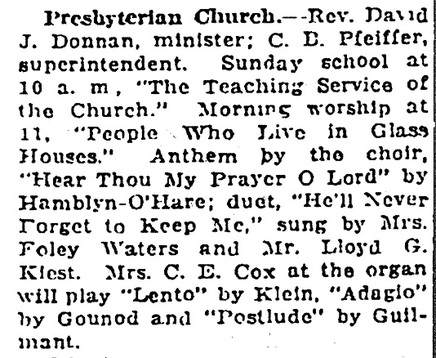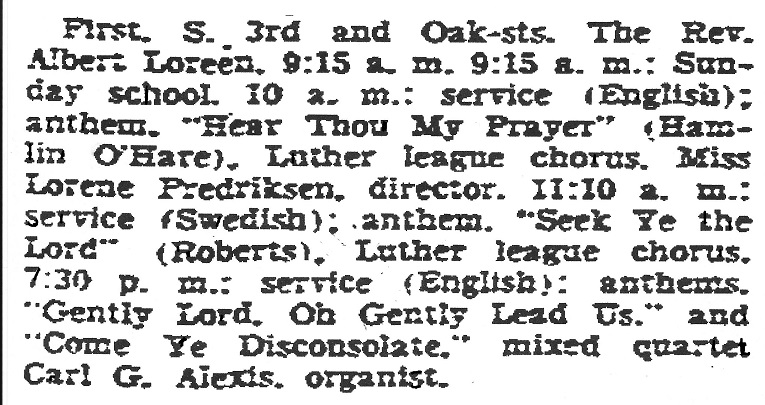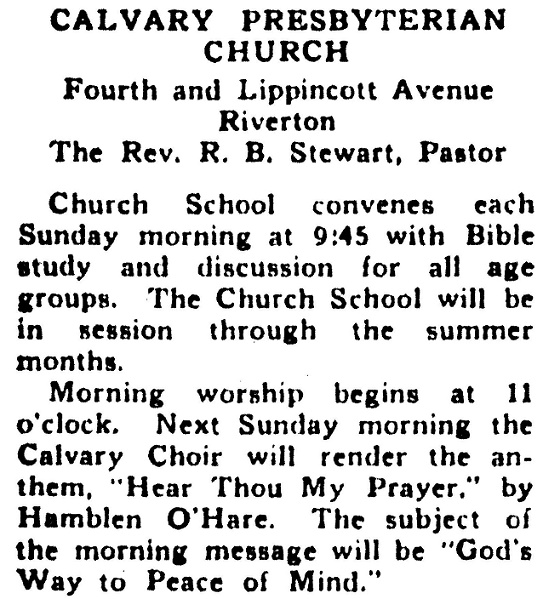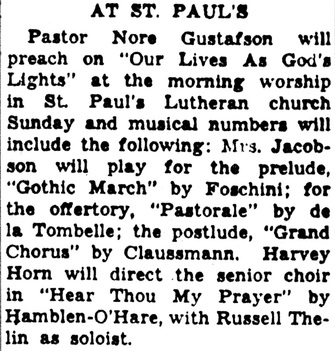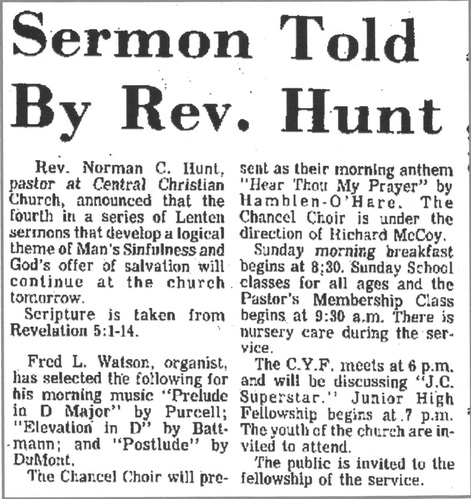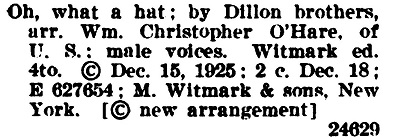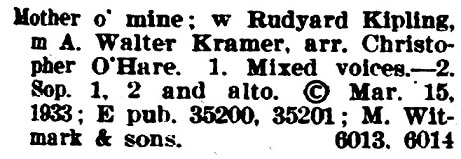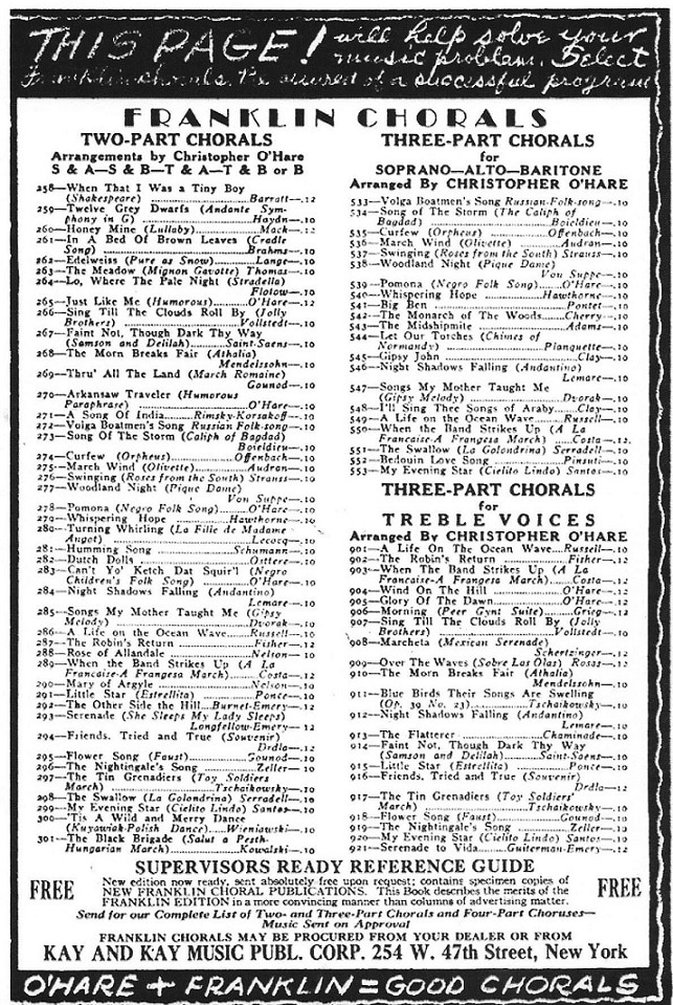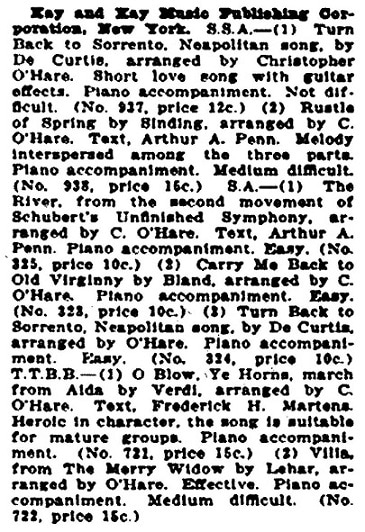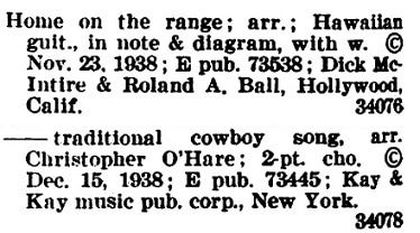O'Hare had begun his Witmark work arranging instrumental and popular song tunes for band and/or orchestra. However, with experience directing choirs and other vocal performances, it's no surprise that he eventually became a respected vocal arranger. His first published vocal ensemble arrangements began in 1905 with a small number of his own compositions for Witmark. By 1906. the Witmark catalog included his arrangements of several songs by popular Witmark composers. (His vocal ensemble compositions can be found by clicking here.)
|
Earliest Witmark Vocal Arrangements (1906)
On March 15, 1906, Witmark copyrighted O'Hare's mixed quartet arrangement of Bryan and Edwards popular
In My Merry Oldsmobile. A copyright search indicates that it was probably O'Hare's first published vocal arrangement of someone else's song. Later 1906 O'Hare vocal arrangements include Fleming and Florant's Only a Message from Home Sweet Home, Dave Reed, Jr's The Honeybee's Honeymoon for female voices, Reed and Ball's Love Me and the World Is Mine for male, female, and mixed voices, Justin Wheeler's The Stars, The Stripes and You for male voices, and Lenox and Sutton's Smile on Me and Young and Ellis' When Love Is Young, both for male and female voices. |
In The Story of the House of Witmark: from Ragtime to Swingtime (1939), Isidore Witmark and Isaac Goldberg describe Love Me, And the World Is Young as Ball's "first smash hit" and add that it "was translated into almost every principal language."
More Witmark Quartet Series (1907-1911)
|
Despite the indication that Charles Shattuck arranged the 1907 Witmark Collection of Male Quartettes, it was a compilation of six arrangements by Shattuck, two by Theo Westman, and seven by O'Hare: Waiting for a Certain Girl from the show The Spring Chicken; Katie Darling, I Am Waiting by McCormick and Kendall; As Long As the World Rolls On by Graff and Ball, I'd Live Or I Would Die for You by Reed and Ball; Virginia by Casey, Where the River Shannon Flows by Russell; and My Arizona Girl by Douglas and Kendall.
Witmark and Goldberg identify Charles F. Shattuck as a "noted minstrel basso" who had arranged for a variety of publishers. Since Shattuck had died in late 1905--well before this Witmark volume--the Witmark, brothers probably retained his name to promote the collection, adding more recent work by other arrangers. In 1910, O'Hare arranged Weslyn and Lodge's Temptation Rag song, again as part of Witmark's Excellent Quartette Arrangements series. By 1911, he was collaborating with others, including Louise Dressler, on more vocal arrangements for male and mixed voices.
|
Other O'Hare male quartet arrangements collected with Temptation Rag in The Witmark Collection of Quartets for Male Voices, No. 15 include Armstrong and Clark's Shaky Eyes, Gardenier and Brockman's If I Could Gain the World by Wishing I Would Only Wish for You, Brockman's Tie Your Little Bull Outside, and Shields and Ball's Just for a Girl.
Huntzinger & Dilworth Religious Anthems (1916)
O'Hare's collaboration with Frederick H. Martens--poet/lyricist, biographer, translator, music critic--seems to have begun in late 1915 with a lyric by Martens and music by O'Hare. It continued with Huntzinger and Dilworth and Hinds, Hayden, and Eldredge religious anthems for which O'Hare arranged, rather than composed, the accompaniment for Martens' lyrics.
Hinds, Hayden, & Eldredge Religious Anthems (1917)
|
Again working with Martens, O'Hare arranged several religious anthems for Hinds, Hayden, & Eldredge during 1917. These were later transferred to and reprinted by Broadcast Music.
Although the covers credit O'Hare as composer, the first page credits another composer and O'Hare as arranger. For that reason, I include the anthems here rather than in the Composer--Sacred Music section. Martens drew his lyrics from scripture but revised them for singing. For example, Take No Thought for Your Life's lyric comes from Matthew 6: 25-29, with the well-known King James version lines ("And why take ye thought for raiment? Consider the lilies of the field, how they grow; they toil not, neither do they spin") changed to the rhyming "Why seek raiment to be winning, the lilies of the field that grow, they of toiling and of spinning, nothing care and nothing know." |
|
John Franklin Arrangements
|
In the late 1910s and 1920s, O'Hare arranged for the John Franklin Company. Most commonly, his Franklin arrangements consisted of famous composers' melodies arranged by O'Hare with original lyrics by John Franklin or E. M. Carroll. These arrangements appeared in educational series intended to familiarize students with classic tunes.
O'Hare included a few international and African American folk songs, humorous paraphrases (such as his of Arkansas Traveler in which the traveler is a mosquito rather than a man), and a small number of his original children's songs. The slides illustrate O'Hare's diverse John Franklin work. |
As shown below, a small number of O'Hare's John Franklin arrangements attracted the attention of and garnered praise from Musical America critic A. Walter Kramer.
Traditional Irish Songs
In early 1917, O'Hare was busily working on an extensive series of traditional Irish songs, arranged for either four-part chorus or quartet.
Review in Musical America: The first seven arrangements in this series prompted composer and critic A. Walter Kramer (1890-1969) to write a positive, detailed review in his regular column for Musical America:
There is nothing new about arranging traditional Irish songs, either as solos or in choral form. Herbert Hughes, Sir Charles Villiers Stanford, William Arms Fisher, Arthur Whiting--these are some of the worthy men who have devoted time and thought to the subject. But a good arrangement is always welcome and the arrangements by Christopher O'Hare, just published, fall under this heading.
Irish song is something that Mr. O'Hare holds dear and in giving his attention and ability to these arrangements he has worked con amore. This is made evident in the results. Fully fifty-two will be out by next September. . . .
For mixed voices there are The Coolin, The Kerry Dance, Believe Me If All, and The Meeting of Waters. Mr. O'Hare knows how to write for voices; every one of the arrangements shows it. And he has given lots of variety to his offering by placing his melody at will in the different parts. These are not arrangements where one finds the melody always in the soprano. The melody in The Coolin, for example, is in the bass and in Believe Me it opens in the tenor alone, answered by the other voices on the third measure. There are distinct skill and appreciation of values shown in all of them, guided by fine musicianship and understanding of the spirit of Irish folk-song.
Nowhere is this understanding better illustrated than in Mr. O'Hare's [comment] on his arrangement of Tho' Dark Be Our Sorrows, where he suggests that if the piece be sung slowly and broadly, it "will take on the solemn grandeur of a true Irish saga." And one has but to try it to prove that this is so. This number, The Low-Backed Car and The Minstrel Boy are admirably set for male voices. In the last named, Mr. O'Hare's harmonization is stunning. When the text is "the minstrel fell," he sets the melody in B minor (the key of the song is D major) and gets just the necessary sad note for a moment here.
The arrangements have been made (both the male and mixed) for four parts throughout. There is no doubling in any of them, not even for a single note. Thus Mr. O'Hare exhibits a true gift in arranging his melodies finely with economy of means. From a practical standpoint this is also important for it renders all the pieces usable by quartets, as well as by choral organizations. --A. Walter Kramer, Musical America
Erin: A Lament, Musical America, and Mme. Schumann-Heink: As O'Hare's project grew, Musical America focused on a solo arrangement of one tune that O'Hare also included in his four-part quartet/choral series:
In Erin Mr. O'Hare has arranged for a solo voice (medium) and piano an ancient Irish melody that is set off in splendid manner through his artistic work. He was praised recently in these column for his arrangements of Irish melodies for chorus of male and mixed voices; here again he shows himself a gifted folklorist. His accompaniment is musicianly and appropriate and sounds the tragic note of this lament strikingly. The text is by Frank Sheridan, the well-known actor, and is also to be commended. --A. Walter Kramer, Musical America |
|
This tune caught the attention of famed contralto Madame Schumann-Heink as evidenced by 1917 Chicago and Boston concerts. According to a Chicago source, Schumann-Heink gave a "sympathetic delivery of the piece to open her second group." The Musical Courier's "Schumann-Heink and Melba Welcomed Back to Boston" referred to the "reminiscent sadness" of her performance of this Sheridan-O'Hare collaboration. |
In April 1917, The Catholic Choirmaster compared the old tune to a Gregorian chant:
The Spiritual Deep River (1917)
Just as A. Walter Kramer appreciated O'Hare's arrangements of traditional Irish tunes, the critic also praised O'Hare's arrangement of Deep River, a spiritual that had only recently come to public attention:
Deep River is in the air and has been since the winter of 1916. No song has since appeared more frequently on recital programs. Made popular in the H. T. Burleigh version, there followed a version by William Arms Fisher (this latter based on Coleridge-Taylor's piano transcription of this old negro spiritual), and we now find Mr. O'Hare's arrangement for voice with piano accompaniment. |
World War I Arrangements
In an October 1917 issue of Musical America, Frederick H. Martens,for whose lyrics O'Hare occasionally composed or arranged music, gathered publishers' opinions about World War I's effect on American music. Frank Sheridan, owner of John Franklin Music Company, was among those who voiced his opinion:
Martens opens the John Franklin section of his article with Sheridan's stab at "war babies"--popular war songs flooding American publishers and ends with Sheridan's praise of O'Hare's choral arrangements of traditional patriotic songs:
As he remarks, 'The stuff which has been placed before us, fertilized by the war spirit, would make the judicious grieve, did we not know it is but froth which must be blown away.
'In the army formed and now forming are the men whose genius will place the American composer upon the pedestal he has strive for. From them we will learn heavens and hells of life unknown to us. And till they come back and, like the minstrel of old, sing us, each, his soul, I fear we will have gained nothing in music from the war.'
Mr. Sheridan has also found that the older songs of patriotism are meeting with the greatest favor, 'perhaps because they are known to all.' As an instance he cites Christopher O'Hare's splendid arrangements of The Battle Hymn of the Republic and The Minstrel Boy*, taken up by the army glee clubs, 'their glorious melodies treated in a manner to suggest a tremendous body of men in movement, a notable and colorful departure in chorus writing n this well-known arranger's part.'
*The Minstrel Boy is one of Irish poet-songwriter Thomas Moore's songs that O'Hare had included in his recent series of Irish song arrangements and which A.Walter Kramer had singled out for comment.
Later John Franklin Arrangements
Although O'Hare continued arranging melodies from composers such as Beethoven, Grieg, Schumann, Dvorak, and Lecocq with modern lyrics for school children, these arrangements also included Ben Jonson's Drink to Me Only with Thine Eyes set to a traditional English tune, and at least two African American songs:
Grandmother's Songs (1926)
|
O'Hare's reputation as an arranger, which included A. Walter Kramer's repeated praise, led to one of his most ambitious and interesting projects. This venture involved listening to an elderly white Southern woman sing slave songs and other folk songs learned as a young girl. Born March 25, 1857, a decade before O'Hare, Lucy Harvie would have been not quite seven when her mother, little sister, and "Mammy" fled Atlanta for her grandfather's Wilkes County plantation (between Athens and Augusta) after learning of Sherman's March to the Sea.
Her eventual husband George Baldwin's introduction to the collection describes how Lucy learned slave songs during her plantation stay: There she knew many happy hours playing with the little darkies at the 'Quarters,' singing with them such songs as 'Big Eye Br'er Rabbit' and 'The Patrol,' or listening while their elders sang the beautiful and melancholy 'Spiritual,' such as 'Don't Yuh Grieve After Me' and the 'Mournin' Dove,' or danced and patted time to such lively tunes as 'Johnny Booker' and 'Ole Dan Tucker.' O'Hare listened to these plantation songs and to songs Lucy Harvie later learned from Georgia mountaineers and from black stevedores during a Mississippi steamboat trip after the war. He transcribed what he heard and arranged the songs for publication.
|
Precisely when Baldwin and O'Hare began collaborating cannot be pinpointed. However, Lucy Harvie Baldwin's death on February 18, 1923, proves that they had started years before the collection's 1926 publication. The 1920 U.S. Federal Census shows Mr. and Mrs. George Baldwin living at S. 45 Park Ave., Manhattan, with their Swiss-born butler and a French-born chambermaid. Somehow she and O'Hare connected during her time in New York.
The Baldwins had previously lived in Savannah, Georgia, and their former home is now considered an "architectural treasure."
Following Mrs. Baldwin's death, her husband George Johnson Baldwin--M.I.T. graduate, and wealthy former president of street railways and electric companies in Georgia, Florida, and Texas, civic leader and philanthropist--privately published the folk song collection. He explained her motive behind the collection, the transcription and arrangement process she and O'Hare went through, and the rarity of some songs preserved as a result of their collaboration:
The Baldwins had previously lived in Savannah, Georgia, and their former home is now considered an "architectural treasure."
Following Mrs. Baldwin's death, her husband George Johnson Baldwin--M.I.T. graduate, and wealthy former president of street railways and electric companies in Georgia, Florida, and Texas, civic leader and philanthropist--privately published the folk song collection. He explained her motive behind the collection, the transcription and arrangement process she and O'Hare went through, and the rarity of some songs preserved as a result of their collaboration:
The fact that the children of her family and friends have always loved these songs emboldened the writer to think that perhaps other children might love them too. So she searched her memory, and sang them to a musician, who wrote down the tunes as she remembered them and then arranged them in their present form. To the best of the writer's knowledge some of the songs have never been printed, possibly never even been written down before.
In his Foreword to Grandmother's Songs, O'Hare speaks of the challenge a professional musician faces when attempting to preserve folk songs that often do not conform to musical expectations and conventions.
Although a long-time, widely-respected music editor, O'Hare conveys his regard for Mrs. Baldwin's expertise as the person who had learned the songs first hand and for the precious role old songs play in triggering memories.
Although a long-time, widely-respected music editor, O'Hare conveys his regard for Mrs. Baldwin's expertise as the person who had learned the songs first hand and for the precious role old songs play in triggering memories.
More Sacred Huntzinger Arrangements (1928)
O'Hare's vocal arrangement of Hamblen's anthem exemplifies the adaptability and long life of religious anthems. With a lyric adapted by Hamblen from Psalm 86 and a musical setting by O'Hare, this piece crossed denominations and at least four and a half decades.
Late Witmark Arrangements (mid-1920s to early 1930s)
Although much of O'Hare's work for Witmark appears to have ended in the 1910s, he continued some vocal arranging.
Mother O' Mine (1933)
|
In 1917, A. Walter Kramer had praised O'Hare's John Franklin arrangements of Irish songs and the spiritual Deep River. In 1933, 65-year-old O'Hare completed two choral arrangements of Kramer's setting of Rudyard Kipling's poem "Mother O' Mine," published by Witmark. Although Kramer completed the 4-part male voices arrangement, O'Hare completed the 4-part mixed voices and 3-part female voices arrangements.
|
Kay & Kay
The March 1930 issue of Music Supervisor's Journal included a full-page advertisement for O'Hare's Franklin Chorals, now property of Kay and Kay.
Titles in the advertisement reflected work O'Hare had completed for John Franklin before beginning to arrange for Kay and Kay. The Kay and Kay choral listing below for educators reveals several later arrangements as do the copyright records:
O'Hare was now in his early seventies.
Background image, top of page: Detail from one of O'Hare's vocal arrangements published by Witmark
